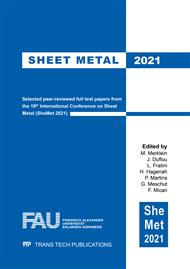p.35
p.41
p.49
p.57
p.65
p.73
p.81
p.89
p.97
Effect of Different Tool Geometries on the Mechanical Properties of Al-Al Clinch Joints
Abstract:
The use of clinch joints, e.g. vehicle structures, is determined by the reliability of the joint and its strength properties - in particular the fatigue strength. Clinch connections offer the advantage over form-closure and force-closure processes that they can also be used for hybrid material combinations. In order to be able to evaluate the influence of the geometry parameters such as e.g. undercut, neck thickness or also base thickness on the fatigue behavior, three clinch connections (in optimum and compromise design) with different tool parameters were designed and examined using the example of a joining task with aluminum sheet material. For this purpose, fatigue curves (F-N curves) in the range of high to very high numbers of load cycles (N = 105 to 107) were determined. In this load cycle range, a so-called "neck fracture" is mainly to be expected as the type of failure, whereas for quasi-static tests, a “buckling” is more likely to occur. The tests were carried out on single-cut overlapping shear tensile specimens. Metallographic and scanning electron microscopic examinations of the joints and the fracture surfaces served to identify the crack initiation site and to clarify the respective type of failure. Significant differences in the damage behaviour of the three clinching variants could be shown. This observation enables one step into the direction of fully understanding the relationship along the causal chain "joint requirements - joining process - fatigue strength". Thus the adaptability of the clinching process can be improved.
Info:
Periodical:
Pages:
65-72
Citation:
Online since:
April 2021
Authors:
Price:
Сopyright:
© 2021 Trans Tech Publications Ltd. All Rights Reserved
Share:
Citation:


